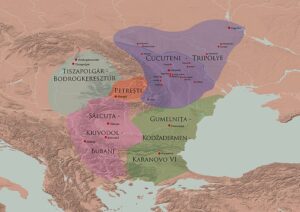Between East and West: Trypillian culture and its place in civilizational processes on the territory of Eastern Europe (6th-3rd millennium B.C.)
Oleksandr Ishchuk, Ph. D. (Kyiv, Ukraine).
Abstract
The article attempts to analyze the place of the Trypillian culture (Kukuten-Trypillian cultural community) in historical processes on the territory of Eastern Europe in the 6th-3rd millennia B.C. It is emphasized that mutual relations between Western and Eastern civilizations in the specified period played an important role in the formation of the population that lived in the territory of ancient Ukraine. The possible influences of various ancient cultures on the formation and activity of the Trypillian civilization are analyzed. The influence, judging by everything, is felt from various civilizations, both from the West and from the South and the East. On the basis of archaeological research of recent decades, an attempt has been made to trace the influence of the Trypillian culture on neighboring civilizations that existed after its decline.
Key words: Kukuten-Trypillian cultural community, Trypillian culture, settlements, proto-cities, buildings, temples, ceramics, tools, agriculture, hunting, fishing, everyday life, construction.
The Trypillian archaeological culture or the Kukuten culture, also known as the Kukuten-Trypillia cultural community, is an archaeological culture of the Neolithic and early Eneolithic (approximately 5500-2750 B.C.). The Ukrainian name of the culture comes from the name of the village of Trypillia in the Kyiv region, and the Romanian name comes from the Romanian village of Kukuten, where the first archaeological finds of artifacts of this culture were discovered at the end of the 19th century. On the territory of modern Ukraine, the Trypil culture was discovered by the Ukrainian archaeologist of Czech origin, Vikentii Vyacheslavovych Khvojko.
According to the latest historical research, the Trypillian culture reached its peak between 5500 and 2750 B.C., was located between the Carpathians and the Dnieper in the territories of modern Romania, Moldova and Ukraine, with a total area of more than 350,000 km². During the heyday of culture, it had the largest settlements in Europe, the number of inhabitants of some of them exceeded 15 thousand people.
One of the features of Trypillian culture was the huge area of distribution (about 190 thousand km²). During its heyday (at the end of the middle stage), the population of the entire territory of the Tryplian culture, according to various estimates, was from 400 thousand to 2 million people.
Almost 5 generations of researchers, historians and archaeologists worked on the study of Trypillian culture in Ukraine (for example, Vikentiy Khvoyka, Vadym Shcherbakivskyi, Yaroslav Pasternak, Oleg Kandyba, Tetyana Passek, Valentin Danylenko, Mykola Shmaglii, Mykhailo Videyko and others) – more than 180 people in total. Most of them took part in regular archaeological expeditions and excavations, which were carried out in most of the territory of Ukraine. The bibliography of publications on the history of the Trypillian culture in Ukraine (only scientific and popular scientific printed works) currently has more than 2,500 items, including more than 60 monographic studies published over the past 130 years.
The largest archaeological treasures of the Trypillian culture are collected in the National Museum of the History of Ukraine and the Archaeological Museum of the Institute of Archeology of the National Academy of Sciences of Ukraine. There you can see wonderful ceramics, clay figurines and models of houses and temples. In more than 60 museums of Ukraine – in Lviv, Odesa, Vinnytsia, Cherkasy and other cities, in rural museums, antiquities of Trypillian culture are also exhibited.
Numerous archaeological collections are exhibited in museums and accumulated in universities, research institutes and private collections, such as the private museum “Platar” (Kyiv, Ukraine). In addition, collections of ceramics and other products from the period of existence of the Trypillian culture are kept in museums in Romania, Moldova, Poland (Krakow, Warsaw, Poznań), Great Britain (London), Austria (Vienna) and others.
In Ukraine, museums and places of ancient settlements of the Trypil culture, as well as archaeological excavations on the Dnieper, Southern Bug and Dniester – attract many tourists. For example, a museum and a monument to the researcher Vikenty Khvoika were opened in the village of Trypillya (Kyiv region). A few years ago, there was an opportunity to visit the Verteba cave (Ternopil region, Ukraine), in which the people of Trypillya lived for a long time. Archaeological research, which began here in the 19th century, is currently being continued by Mykhailo Sokhatskyi, the director of the Borshchiv Historical Museum.
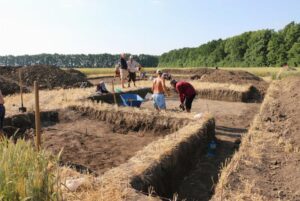
Hundreds of painted vessels and clay figurines were discovered in the cave labyrinth. Excavations and searches there continue to this day. It is not surprising that many books and articles have been published about these objects related to the history of Trypillian culture in recent years, documentaries and news stories have been filmed, and photos have been posted on the Internet.
What was the place of Trypillian culture in those civilizational processes that took place in the Copper Age? Are there reasons to believe that other, earlier great civilizations had an impact on the formation and development of the Trypillian culture? And what influence did the Trypillian culture itself have on subsequent civilizations that existed after its existence? We will try to consider these questions in this article.
Today, Ukrainian historians have come to the conclusion that the Trypillian culture is an integral part of a large circle of ancient agricultural cultures of the Neolithic and Copper Age. Among them are such archaeological cultures on the territory of Eastern Europe as Boyan, Dudesti, Karanovo, Gumelnytsia, Khamanjiya, Varna-Vincha. Researchers sometimes combine them into the so-called “civilization of Old Europe”, the time of existence of which in the territory from approximately the east of modern Italy to the Dnieper falls on the 6th – 4th millennium B.C.
There is no doubt that many historians and archaeologists, as well as citizens who are interested in the history of the Ukrainian people, are interested in the question of the origin of the Trypillian culture, its relationships with other archaeological cultures of Eastern Europe and Asia.
The legacy left by Trypillian culture is huge. It can be said that historians and archaeologists have thousands of objects left to study. On the territory of Ukraine alone, sights of Trypillian people are known in 15 oblasts (regions), and accidental finds – in another four. In total, more than 2,300 monuments are known, including settlements, burial grounds and burials, treasures and individual finds .
It should not be forgotten that some of the monuments of the Kucuteni-Trypillian community are also located on the territory of Moldova and Romania, and there are also a lot of them. Therefore, some researchers tend to believe that the number of monuments is somewhat underestimated, and call even larger numbers. Every year, archaeological expeditions continue to search for and excavate settlements of the Trypillian culture on the territory of Ukraine. And it brings a lot of new discoveries.
The mapping of settlements shows the gradual spread of the Trypillian culture in Ukraine, from west to east. As for the question “Are the Trypilians our ancestors?”, it is rather difficult to answer, because the Trypilian population itself was quite heterogeneous. And a lot of time has passed since that historical period – several thousand years. All this complicates the work of scientific historians and archaeologists.
Nevertheless, the preserved burials of people give grounds for some initial conclusions (albeit not yet final, but important ones). In particular, after analyzing the human bones from burials from the Verteba cave for the purpose of DNA study, genealogists came to the conclusion that the Trypillian women really gravitated more towards the Balkan region and were partly of the Mediterranean anthropological type, while the men belonged to the late Cro-Magnon type, that is, they were autochthonous (local origin). It is clear that it is still too early to speak about such conclusions definitively. Research should continue .
According to some researchers, during the Trypilian period, a logical merger of the Trypilian-Kukutenians with local Neolithic peoples took place – the Bugo-Dniester community (these were the descendants of the Mizyna archaeological culture) and the Dnipro-Donetsk community, forming the genetic core of the future population on the territory of ancient Ukraine. It is clear that all this had an impact on the historical development and subsequent formation of the Ukrainian people.
Every great world civilization left behind not only small settlements, but also entire cities. In the case of the Trypillian people, we can talk about the existence of proto-cities – large settlements where tens of thousands of people lived. At the beginning of the study of Trypillian culture, not everyone could believe that such settlements existed at all. This question was considered debatable for some time. Therefore, the study of large settlements of Trypilians – proto-cities (with the help of new technologies of the 20th century) aroused great interest in Ukrainian society.
Research has been actively conducted since the middle of the 20th century. Research in the 1970s and 1980s was particularly successful. Thanks to geomagnetic aerial photography and the works of military topographer K. Shishkin, geophysicist V. Dudkin, archaeologists M. Shmaglii, K. Zinkivskyi and many others, the world learned about the largest Trypillian settlements of the Copper Age in Europe. In 1981, the Institute of Archeology of the Ukrainian SSR created a complex Trypillian expedition, which consisted of four detachments and actively studied this issue for more than ten years. It was possible to involve geophysicists in the case. It was they who developed the method that made it possible to find the sites of ancient buildings without “entering” the ground .
Historians and archaeologists assumed that they would be able to find not just settlements, but large settlements (proto-cities) of Trypillians. Couldn’t all people live only in small villages, with 20, 30, 50 houses? The presence of fertile soils, forests, and rivers indicated that there must have been large settlements where hundreds and thousands of people could live.
Life has shown that it was a difficult task for archaeologists to make detailed plans of such large settlements buried under the thickness of the earth. After all, the buildings themselves were destroyed a long time ago, only their underground foundations could be found. It was impossible to excavate many of them, because it required hundreds or even thousands of years of excavation for just one settlement. It was only possible to partially excavate the objects that seemed to archaeologists to be the most important, iconic, and interesting. Therefore, future generations of historians and archaeologists can not worry: the work on the study of Trypillian settlements will be enough for everyone for a long time .
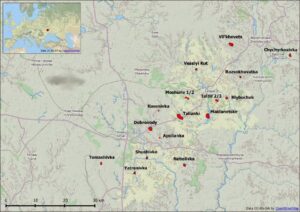
According to the results of research, historians, archaeologists and geophysicists managed to find the largest proto-cities of Trypillians:
1) Near the village Talyanki – a settlement existed around 3700 B.C., with a population of 15,000 – 25,000 inhabitants, up to 2,700 houses, its area was 450 hectares. Talianki was the largest city of Trypilians in 3600 – 3500 B.C.
2) Near the village Nebelivka – the settlement existed around 4000 B.C., its area was 300 hectares. It was the largest Tripillian proto-city of its time.
3) Near the village. Maidanetske – the settlement existed around 3700 B.C., its population was 6000 – 10000 inhabitants, there were up to 1575 houses, its area was 270 hectares.
4) Near the village. Dobrovody – the settlement existed around 3800 B.C., had a small population of up to 10,000 inhabitants, and its area was up to 250 hectares.
5) Near the village. Vesely Kut – the area of the settlement was up to 150 hectares, the number of inhabitants and houses has not yet been counted. However, we are talking about thousands of residents.
6) Near the village Kosenivka – an area of 120 – 180 hectares, the number of inhabitants and houses has not yet been calculated. However, we are talking about thousands of residents.
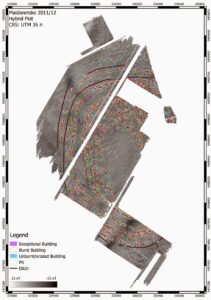
It must be said that these proto-cities had certain similarities between themselves. This was immediately noticed by researchers. So, the features of these large Trypillian settlements – proto-city should be considered as follows:
– All settlements have a large area, 100-450 hectares;
– the population could reach up to 10,000 people or even more;
– The circular structure of the proto-city with a square in the center, the presence of streets (up to 180 meters long);
– all settlements were surrounded by a moat, that is, the population in them, apparently, could constantly prepare for defense;
– on the territory of the settlements there were residential, economic, and temple structures (single houses that were not part of the street system);
– these proto-cities existed in one and the same place for quite a long time (at least tens of years), could provide all the inhabitants with food, tools, earthenware, that is, practically everything necessary for life.
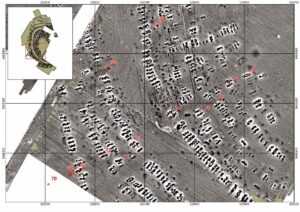
It was interesting for archaeologists to trace the features of the architecture of Trypillian settlements. The buildings of Trypillian proto-cities were built close to each other, forming up to two lines of fortifications. The first line surrounded the center, and the second was at a distance corresponding to the flight of the arrow from the first. All this is very well visible on magnetic aerial photographs, and is also confirmed by the materials of archaeological excavations. The scale of the fortifications of the Trypillian settlements is impressive – the elliptical citadel of the settlement near Maidanetskyi was 1 km long, the same one in Talyanki was 3.5 km long. You can imagine the amount of construction work that had to be done to build such settlements. At the same time, it should be remembered that there was no powerful construction equipment at that time.
The discovery of the Tripillian proto-cities became one of the biggest archaeological sensations in the history of research into the civilization of Old Europe – along with the “golden” Varna necropolis, Neolithic sanctuaries – “rondels” and copper mines of the 5th millennium B.C. in the Balkans. Researches of Tripillian proto-cities continue every year, including with the participation of archaeologists from different countries of the world – Great Britain, USA, Switzerland, France, Germany, Romania, Moldova, and other countries.
Archaeological excavations provided a lot of factual material for the reconstruction of buildings that existed in settlements. Historians and archaeologists established that Trypillian houses had a frame-column construction, among them were: one-story, two-story, and even three-story. Inter-floor and attic floors were coated with clay.
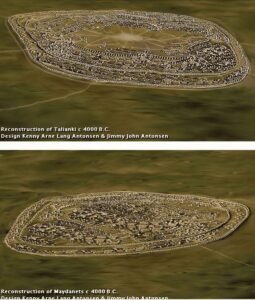
(continued)
